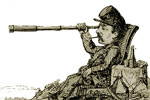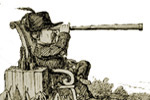



 Go Back |
Early Balloon Flight |
 Aeronautics |
Compared to Europe, ballooning was slow to develop in the United States even though respected Americans such as Benjamin Franklin and Thomas Jefferson told the American public about the aeronautical developments in Europe. False reports in the U.S. press of flights probably contributed to the public's disinterest and skepticism. For instance, the New York Sun had reported that an Irish balloon enthusiast, Monck Mason, and his companions had landed in South Carolina after ballooning across the Atlantic Ocean. The article turned out to be a hoax. Another published account, which described a flight by James Wilcox in Philadelphia that reputedly had occurred on December 28, 1783, also was false.
Although Peter Carnes flew a number of tethered flights in Bladensburg, Maryland in June 1784, the first real balloon flight in the United States did not occur until the Frenchman François Blanchard ascended from the yard of the Washington Prison in Philadelphia, Pennsylvania, on January 9, 1793. That day, President George Washington, the French ambassador, and a crowd of onlookers watched Blanchard ascend to about 5,800 feet (1,768 meters). He then drifted to a landing in Gloucester County, New Jersey. It was Blanchard's 45th ascension. Blanchard carried the first piece of airmail with him, a "passport" presented by President Washington that directed "all citizens of the United States, and others, that…they oppose no hindrance…to the said Mr. Blanchard" and help in his efforts to "establish and advance an art, in order to make it useful to mankind in general." Blanchard's flight was successful, and he planned a second flight. But he couldn't pay off his debt from his first flight and raise enough funds to cover his new expenses. He tried raising money by charging to fly small tethered balloons with animal passengers in them that were attached to parachutes. A fuse would release the parachutes automatically and the animals would float back to earth. The income generated by this scheme was still insufficient, however, for his needs. After a few more efforts to raise money, he returned to France in May 1797. The first successful American aeronaut was Charles Ferson Durant. On September 9, 1830, he made his first ascent from New York's Castle Garden. He was the first person to drop leaflets from the sky, scattering copies of poems he wrote that told of the joys of flight.
As in Europe, ballooning in the United States became a regular form of entertainment at fairs and celebrations. The foremost American aeronauts were Durant, John Wise, Thaddeus S.C. Lowe, John LaMountain, and Rufus Wells. The public referred to them as "professors." Wise often dropped cats or dogs in parachutes from his balloons. Sometimes, Wise permitted his balloon to burst and serve as a parachute to lower him to the ground. He also invented the ripping panel on the balloon. The Atlantic Ocean presented an ongoing challenge to American aeronauts. Wise tried for more than ten years to raise funds for a balloon flight to Europe. He finally succeeded in 1859 when O.A. Gager, a wealthy balloon enthusiast, financed the building of the 50,000-cubic-foot (1,416 cubic-meter) Atlantic, which had a lifeboat suspended beneath it. On July 2, 1859, Wise, LaMountain, Gager, and a reporter left St. Louis and flew 809 miles (1,302 kilometers) in this balloon to Henderson in Jefferson County, New York. The flight, which lasted 19 hours 50 minutes, was threatened by a violent storm that almost drove them into Lake Ontario. Wisely, the aeronauts, instead of relying on their lifeboat, cut it adrift and gained the additional lift they needed. Wise also jettisoned a bag of mail consigned to the group by the United States Express Company. This was the earliest airmail delivery in the United States. The flight established an official world distance record for non-stop air flight that would stand until 1910.
After that flight, LaMountain took possession of the damaged Atlantic and repaired it in anticipation of another flight. In September 1859, with John Haddock, editor of the Watertown, New York Reformer, LaMountain ascended from Watertown in what was billed as a "short experimental flight." However, winds blew the balloon into Canada where the two were stranded in the wilderness for four days without food or adequate clothing until they reached shelter. LaMountain's next foray into ballooning would be in the U.S. Civil War. Lowe, who would also use balloons during the Civil War, had the urge to cross the Atlantic Ocean by balloon too. He built the Great Western for that purpose but could not get enough gas to inflate it in New York. He took the balloon to Philadelphia to be inflated. He departed from there on June 28, 1860, on a short test flight, landing on the sand flats of New Jersey. Lowe had planned his ocean voyage for September 8, 1860. Unfortunately, shortly before his planned departure, a sudden wind squall burst and completely destroyed his balloon. Lowe persevered, however. He decided to follow the advice of Joseph Henry, secretary of the Smithsonian Institution, and begin with a trial flight in the Midwest to take advantage of the air currents coming from the west. He left Cincinnati, Ohio, on April 20, 1861, in the Enterprise, but the winds carried him into South Carolina where he received a hostile reception from the local people. He took off again immediately, but his second landing was equally inhospitable and he was jailed. A co-balloonist procured his release, but he was soon arrested again as a Yankee spy. With the onset of the U.S. Civil War, he put thoughts of an Atlantic voyage aside and joined the Union army, which may have saved him from drowning in the Atlantic. On June 17, in 1861, on the grounds of the Columbia Armory in Washington, the specially equipped Enterprise ascended on tethers to a height of 500 feet, carrying Lowe and representatives of the American Telegraph Company. Using telegraph equipment aboard the ship and cables that ran along one of the rigging wires to the ground and from there to the War Department and the White House, Lowe sent the world's first telegraphic transmission from the air:
The ingenuity of this demonstration was not lost on the commander in chief. Lowe had firmly cemented his relationship with Lincoln. For the rest of the evening of the 17th, the Enterprise was moored on the South Lawn of the White House, while Lowe remained as a guest in the executive mansion. Meanwhile, back in Troy, New York, LaMountain was preparing to accept an offer from another quarter. He had been waiting in vain for word from the War Department, when, on June 5, he received a letter from Major General Benjamin F. Butler, in command of Union forces at Fort Monroe, Virginia. Butler had learned of LaMountain's offer of service and requested that the aeronaut make preparations to journey to Fort Monroe and demonstrate his balloon. LaMountain encountered a number of delays, ranging from financial shortages to the lack of a hydrogen gas generator suitable for use in the field, but he finally arrived in Virginia late in June. He had already heard of Lowe's telegraphic ascent in Washington and publicly dismissed the feat as having "neither value nor advantage."
Ballooning revived after the Civil War, and a new generation of aeronauts emerged who were also caught up with the idea of crossing the Atlantic. It was veteran aeronaut John Wise, however, who managed to secure financing for the venture and build the Daily Graphic, a two-story balloon with a capacity of 600,000 cubic feet (16,990 cubic meters). John Wise and Washington Harrison Donaldson were both parties to and signatories on the contract with The Daily Graphic's publishers, not only John Wise. But he withdrew from the venture because of a dispute with his sponsors and was replaced by his partner W.H. Donaldson, who had performed stunts and acrobatic feats in balloons. Donaldson departed on October 6, 1973, but his attempt was unsuccessful and he landed in the Catskill Mountains in New York, damaging his balloon irretrievably. The balloon in which Donaldson made his attempt was the New Graphic, not the Daily Graphic; he ascended on October 7, 1873, not on "October 6, 1973"; he landed at New Canaan, Connecticut, not in the "Catskill Mountains in New York." He disappeared on another flight two years later when he was forced into Lake Michigan during a storm. Wise also perished in Lake Michigan on September 29, 1879. |